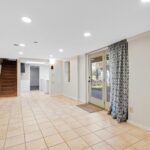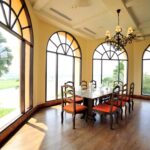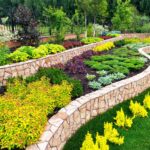The Rise of Conscious Living Spaces
In an era where environmental consciousness is paramount, homeowners are increasingly seeking ways to align their living spaces with their values. The concept of holistic home interiors has gained traction, emphasizing the interconnectedness of our living environments with our well-being and the planet’s health. This approach goes beyond mere aesthetics, focusing on creating spaces that nurture both the inhabitants and the environment.
Understanding Holistic Home Interiors
Harmony with Nature
Healthy interior solutions strive to create a seamless connection between indoor and outdoor spaces. This can be achieved through large windows that invite natural light, indoor plants that purify the air, and the use of natural materials that bring the essence of the outdoors inside.
Mindful Material Selection
The cornerstone of holistic interiors lies in choosing materials that are not only aesthetically pleasing but also sustainable and non-toxic. This includes opting for organic fabrics, reclaimed wood, and natural stone, while avoiding synthetic materials that may off-gas harmful chemicals.
Energy Efficiency
A holistic approach to home interiors also considers energy consumption. This encompasses everything from energy-efficient appliances to smart home systems that optimize heating, cooling, and lighting based on occupancy and natural light levels.
Embracing Eco-Friendly Home Products
The market for eco-friendly home products has expanded significantly, offering consumers a wide array of options to create sustainable living spaces. These products not only reduce environmental impact but often provide health benefits and long-term cost savings.
Sustainable Furniture
Furniture made from reclaimed wood, bamboo, or other rapidly renewable resources has become increasingly popular. Look for pieces certified by the Forest Stewardship Council (FSC) to ensure responsible sourcing.
Non-Toxic Paints and Finishes
Traditional paints and finishes can release volatile organic compounds (VOCs) into the air, compromising indoor air quality. Opting for low-VOC or zero-VOC alternatives helps maintain a healthier living environment.
Energy-Efficient Lighting
LED bulbs and fixtures not only consume less energy but also have a longer lifespan compared to traditional incandescent bulbs. Smart lighting systems can further optimize energy use by adjusting brightness based on natural light and occupancy.
Water-Conserving Fixtures
Low-flow faucets, showerheads, and dual-flush toilets can significantly reduce water consumption without sacrificing functionality or comfort.
The Impact of Eco-Friendly Rugs
Among the various eco-friendly home products available, eco-friendly rugs deserve special attention. These floor coverings play a crucial role in tying room designs together while also contributing to a healthier indoor environment.
Natural Fibers
Eco-friendly rugs often utilize natural fibers such as jute, sisal, seagrass, or organic cotton. These materials are biodegradable and require fewer resources to produce compared to synthetic alternatives.
Recycled Materials
Some innovative rug manufacturers are creating beautiful pieces from recycled plastics, including PET bottles. These rugs not only divert waste from landfills but also offer durability and easy maintenance.
Non-Toxic Dyes
Traditional rug dyeing processes can involve harsh chemicals that are harmful to both the environment and human health. Eco-friendly rugs often use natural or low-impact dyes, ensuring that your floor covering doesn’t introduce toxins into your home.
Sustainable Production Practices
Look for rugs from companies that prioritize sustainable production methods, including water conservation, renewable energy use, and fair labor practices.
Implementing Holistic Design Principles
Decluttering and Minimalism
A key aspect of holistic home interiors is the concept of “less is more.” By decluttering and embracing minimalism, homeowners can create spaces that feel open, calm, and purposeful. This approach not only reduces the need for excessive consumption but also promotes mental well-being.
Biophilic Design
Incorporating elements of nature into the home environment is central to holistic design. This can include living walls, water features, and natural textures that mimic outdoor elements. Biophilic design has been shown to reduce stress, improve cognitive function, and enhance overall well-being.
Personalized Spaces
While following eco-friendly principles, it’s important to create spaces that reflect personal tastes and needs. Custom-made furniture from sustainable materials or repurposed vintage pieces can add unique character to a home while aligning with environmental values.
The Long-Term Benefits of Holistic Interiors
Improved Health and Well-being
By reducing exposure to toxins and creating spaces that promote relaxation and connection with nature, holistic interiors can significantly improve physical and mental health.
Lower Environmental Impact
From reduced energy consumption to the use of sustainable materials, holistic home interiors contribute to a lower overall environmental footprint.
Financial Savings
While the initial investment in eco-friendly products may be higher, the long-term savings in energy costs and durability often outweigh the upfront expenses.
Increased Home Value
As awareness of environmental issues grows, homes designed with sustainability in mind are likely to see increased market value.
Overcoming Challenges in Creating Holistic Interiors
Navigating Greenwashing
With the growing popularity of eco-friendly products, it’s important to be wary of greenwashing. Research certifications and company practices to ensure products truly align with environmental values.
Balancing Aesthetics and Sustainability
While many eco-friendly options are available, finding products that match specific design visions can sometimes be challenging. Working with interior designers experienced in sustainable design can help overcome this hurdle.
Managing Costs
Eco-friendly products can sometimes come with higher price tags. Prioritizing key elements and gradually transitioning to a more sustainable home can help manage costs over time.
Creating a holistic home interior with eco-friendly products is a journey that requires thoughtful consideration and planning. By embracing sustainable materials, energy-efficient solutions, and design principles that promote well-being, homeowners can create living spaces that are not only beautiful but also responsible and nurturing. As we continue to face environmental challenges, the choices we make in our homes can contribute to a more sustainable future, one room at a time.







